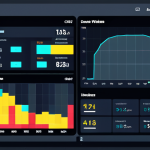Remember those early days of web development? It felt like constantly reinventing the wheel, didn’t it? I sure did, fumbling through obscure errors and manual debugging for hours.
That’s when I realized mastering the right developer tools wasn’t just about efficiency; it was about reclaiming my sanity and making the creative process actually enjoyable.
With AI-driven assistants and cloud-native environments rapidly reshaping our craft, staying updated on these essential instruments is more crucial than ever.
Honestly, the sheer power and predictive capabilities at our fingertips now, compared to even five years ago, is truly transformative. I’ve personally seen how a well-honed toolkit can turn a frustrating bug hunt into a quick fix, or how seamless version control saves countless headaches on collaborative projects.
It’s not just about what the tools *do*; it’s about how they empower you to think less about the mundane and more about innovation. The latest trend I’ve noticed, beyond the obvious AI assistants like GitHub Copilot, is how integrated environments are becoming – tools that anticipate your needs, suggest improvements, and even auto-deploy with minimal fuss.
This isn’t just about faster coding; it’s about a fundamental shift in how we approach problem-solving, making development less about brute force and more about strategic orchestration.
Imagine trying to resolve a performance bottleneck without granular network monitoring or profiling tools – it’s a non-starter. The future, in my view, is headed towards even more intelligent, self-optimizing toolchains that almost learn your coding habits, pushing us towards truly ‘effortless’ development.
Let’s get into the specifics.
Navigating the Debugging Labyrinth: Tools That Save Your Sanity

Honestly, if there’s one area where developer tools truly shine and save me from pulling my hair out, it’s debugging. I remember countless nights staring at a screen, utterly baffled by a seemingly simple bug that just wouldn’t quit. It felt like I was searching for a needle in a haystack, blindfolded. That’s when I realized the sheer power of understanding and leveraging debugging tools beyond just basic console logs. They transform what used to be a frustrating, hours-long ordeal into a systematic, almost enjoyable puzzle. It’s about gaining real-time insight into your application’s state, variables, and execution flow, allowing you to pinpoint the exact moment something goes awry. The shift from reactive, panic-driven bug fixing to proactive, diagnostic analysis has been game-changing for my productivity and, more importantly, my mental health.
1. The Unsung Heroes: Browser DevTools Beyond the Basics
When I first started, browser DevTools felt like just a place to see errors in the console or inspect a button’s CSS. But oh, how wrong I was! Digging deeper, I discovered features like network tab throttling, which lets you simulate slow internet connections – crucial when you’re building for a global audience and not everyone has fiber. I’ve personally caught so many performance bottlenecks by simply seeing how a page loads on a simulated 3G connection. Then there’s the “Sources” tab, where setting breakpoints and stepping through JavaScript execution becomes an art form. You can modify variables on the fly, resume execution, and even inject code snippets. I vividly recall a time when a complex asynchronous function was misbehaving; by carefully stepping through each and block, I could observe the exact state of my data at every single microtask, which led me straight to the logical flaw. It’s like having an X-ray vision into your web application, exposing every hidden interaction and value.
2. Stepping Through Chaos: IDE Debuggers and Their Magic
While browser DevTools are indispensable for front-end, an integrated development environment (IDE) debugger is your lifeline for backend logic or complex full-stack applications. I’ve spent years with VS Code’s built-in debugger, and it feels like an extension of my brain. The ability to set conditional breakpoints, watch specific variables, or even jump directly into a function’s scope is just incredible. There was this one particularly nasty bug in a production microservice that only manifested under very specific race conditions. Trying to log my way out of that would have been a nightmare. Instead, I spun up a local environment, attached the debugger, set a breakpoint on the critical section, and then, using a conditional breakpoint, waited for the exact state I needed. When it hit, I could meticulously examine the stack trace, the call history, and the variable values, discovering a subtle thread-safety issue that I would have never seen otherwise. It’s this level of control and insight that truly elevates debugging from a chore to a refined skill.
Orchestrating Code: Version Control for Seamless Collaboration
Working on a project alone is one thing, but as soon as you bring in another developer, or even just decide to work on two different features simultaneously, version control stops being an option and becomes an absolute necessity. I remember the dark ages of manually zipping up project folders or using some clunky shared drive, only to inevitably overwrite someone else’s changes or lose hours of my own work. The sheer anxiety of that chaotic workflow was palpable. Discovering Git was like finding a Rosetta Stone for collaboration. It didn’t just solve the problem of multiple people touching the same files; it provided a structured, auditable history of every change, every decision, and every branch of development. It’s not just about tracking code; it’s about managing intellectual property and ensuring that everyone is moving in a synchronized, forward direction. The peace of mind it offers, knowing you can always revert to a previous working state, is invaluable.
1. Beyond Git Commit: Mastering Advanced Branching Strategies
Most developers start with Git’s basic , , and . But the real power, I’ve found, lies in its branching capabilities. I’ve personally experimented with various branching models – Git Flow, GitHub Flow, GitLab Flow – and each has its nuances, but the common thread is the ability to isolate work, develop features in parallel, and experiment without fear of breaking the main codebase. I recall a massive refactoring project I was leading where we needed to overhaul a core module while daily feature development continued. Using a long-lived branch, regularly rebased against , allowed our team to methodically transform the old code while the feature team could continue delivering value. It prevented a merge hell scenario and ensured that our production line never stopped. Understanding when to use a feature branch, a release branch, or a hotfix branch isn’t just a technical detail; it’s a strategic decision that affects team velocity and stability.
2. Collaborative Workflows: From Pull Requests to CI/CD Integration
Git, on its own, is a powerful tool, but its integration with platforms like GitHub, GitLab, or Bitbucket transforms it into a collaborative powerhouse. I’ve come to rely heavily on pull requests (or merge requests, depending on the platform) not just for code review but as a central hub for discussion, testing, and even automated checks. There’s a certain magic in submitting your work, seeing automated tests run, and then getting constructive feedback from peers. It fosters a culture of quality and shared ownership. I remember a time when a subtle logic error was caught during a code review on a pull request before it even reached the staging environment, saving us a potential production incident. This tight integration with Continuous Integration/Continuous Deployment (CI/CD) pipelines means that every code change is automatically built, tested, and potentially deployed. This hands-off, automated approach allows me to focus purely on coding, knowing that the safety nets are always there, catching errors early and ensuring a smooth path to production.
Performance Power-Ups: Unveiling Bottlenecks and Boosting Speed
If there’s one thing that consistently frustrates end-users, it’s a slow application. As developers, we often focus on functionality, but overlooking performance is a grave mistake that can lead to lost users and revenue. I’ve personally been on the receiving end of user complaints about sluggish interfaces, and it’s always a wake-up call. The good news is, there are incredible tools out there that let you dissect your application’s performance with surgical precision, moving beyond mere guesswork. It’s not just about making things “faster”; it’s about understanding the underlying resource consumption, identifying inefficient algorithms, and optimizing data flow. The joy of seeing a page load in milliseconds after days of profiling and optimization is truly satisfying, knowing you’ve provided a superior experience.
1. Profiling Prowess: Understanding Your Application’s True Load
When an application feels slow, the first question I always ask is: “Where is the bottleneck?” Is it the CPU? Memory? Disk I/O? Network? This is where profilers become indispensable. Tools like Chrome’s Performance tab, Node.js profilers, or even language-specific profilers (like Java’s VisualVM or Python’s cProfile) provide a granular view of where your application is spending its time. I remember a particularly baffling situation where a simple API endpoint was taking seconds to respond. Initial thoughts pointed to the database, but after running a profiler, I discovered it was actually a deeply nested, inefficient loop in our serialization logic that was consuming 90% of the CPU time. Without the profiler, I might have spent days optimizing the database, only to find marginal improvements. It’s like having a detailed map of your code’s execution, showing you exactly where the hot spots are and guiding your optimization efforts.
2. Network Diagnostics: Decoding the Web’s Hidden Latencies
For web applications, the network is often the unsung culprit behind perceived slowness. It’s not always your server or your frontend code; sometimes, it’s the sheer number of requests, their size, or the order in which they’re fetched. Browser network tabs are my first port of call here. I use them to analyze waterfall charts, identify render-blocking resources, and spot unnecessary requests. I once optimized a landing page that felt sluggish simply by deferring non-critical JavaScript and CSS, and compressing images – changes that were obvious once I saw the network tab’s visual representation of download times. Furthermore, tools like Postman or Insomnia are vital for testing API endpoints in isolation, helping me understand their individual response times and payloads without the overhead of the full application. Understanding how data travels from server to client and back, and optimizing that journey, is a critical step in building truly responsive applications.
Automation Arsenal: Making Repetitive Tasks a Relic of the Past
If there’s one thing that truly grates on me, it’s doing the same manual task over and over again. As a developer, my time is best spent solving complex problems, not configuring build steps, running tests, or deploying code. That’s where automation tools come in, and frankly, they’ve been revolutionary for my workflow. I’ve personally invested significant time in setting up robust automation, and the dividends in terms of saved time, reduced errors, and increased confidence are immeasurable. It’s about codifying processes, making them repeatable, and removing the human element from tedious, error-prone tasks. The shift from a manual deployment process that took an hour to a one-click, fully automated deployment that takes minutes is not just an efficiency gain; it’s a profound change in how I approach the entire development lifecycle.
1. Scripting Your Way to Freedom: Build Tools and Task Runners
From compiling Sass to bundling JavaScript, minifying CSS, or linting code, modern web development involves a dizzying array of repetitive tasks. Build tools and task runners like Webpack, Gulp, Grunt, or even simple npm scripts have become indispensable. I remember painstakingly optimizing image sizes and concatenating files manually – a recipe for inconsistencies and mistakes. Now, I simply define my build pipeline once, and with a single command, it handles everything, consistently and flawlessly. For instance, in a recent project, I configured Webpack to automatically tree-shake unused code, lazy-load components, and generate source maps, all while maintaining a blazing fast hot-reloading development server. This setup means I spend less time configuring and more time coding. The beauty is in their configurability; they adapt to your project’s unique needs, giving you a powerful, customized automation engine right at your fingertips. It truly embodies the spirit of working smarter, not harder.
2. The CI/CD Revolution: From Local Dev to Production in Minutes
Continuous Integration (CI) and Continuous Deployment (CD) are more than just buzzwords; they represent a fundamental shift in how we deliver software. I’ve personally experienced the transformation from anxiety-inducing, manual “big bang” deployments every few weeks to confident, automated deployments multiple times a day. Tools like Jenkins, GitHub Actions, GitLab CI/CD, or CircleCI automate the entire process from code commit to production. Every time I push code, a pipeline springs into action: running tests, building artifacts, scanning for vulnerabilities, and deploying. This reduces human error, ensures consistent environments, and dramatically shortens feedback loops. I recall a time when a critical bug was reported, and because our CI/CD pipeline was so well-oiled, I could push a fix, have it automatically tested, and see it deployed to production within 15 minutes. This agility is simply impossible without robust automation, and it directly translates to happier users and a more responsive business.
| Tool Category | Key Benefit | My Personal Experience / Impact |
|---|---|---|
| Integrated Development Environments (IDEs) | Unified development experience, smart code assistance, integrated debugging. | Drastically reduced context switching, caught errors before runtime with intelligent autocompletion. |
| Version Control Systems (VCS) | Code history tracking, collaborative development, branching/merging. | Eliminated code conflicts, enabled parallel feature development without chaos, peace of mind knowing I can revert. |
| Performance Profilers | Identify performance bottlenecks (CPU, memory, network), optimize resource usage. | Transformed slow applications into lightning-fast experiences, pinpointed exact lines of inefficient code. |
| CI/CD Pipelines | Automated testing, building, and deployment of code changes. | Allowed rapid, confident deployments multiple times a day, caught integration issues early, reduced manual errors. |
| Containerization Tools | Consistent development and deployment environments, application isolation. | Solved “it works on my machine” issues, simplified onboarding for new team members, streamlined production deployments. |
The Rise of AI-Powered Assistants: Your Co-Pilot in Code
Just when I thought developer tools couldn’t get any more exciting, AI-powered assistants started making waves. It initially felt like something out of science fiction, but now, it’s an undeniable reality that’s reshaping how I approach coding. I’ve personally integrated tools like GitHub Copilot into my daily workflow, and the change has been profound. It’s not just about autocomplete anymore; it’s about intelligent suggestions, boilerplate generation, and even complex algorithm proposals. This isn’t about replacing developers; it’s about augmenting our capabilities, freeing us from the mundane and allowing us to focus on higher-level problem-solving and architectural design. The feeling of having an ever-present, incredibly knowledgeable assistant whispering suggestions in your ear is truly empowering, accelerating development in ways I couldn’t have imagined a few years ago. It feels like I’m always pair-programming with an expert who knows every library and framework.
1. Predictive Prowess: How AI Transforms Code Generation and Completion
Traditional autocompletion is useful, but AI-powered tools take it to an entirely new level. Instead of just suggesting method names, they can generate entire functions, classes, or even complex data structures based on comments, function signatures, or existing code patterns. I remember a time when I had to write repetitive API integration code, mapping dozens of fields from one object to another. Copilot, after just a few lines, began predicting the entire mapping, saving me hours of tedious, error-prone typing. It learns from billions of lines of code, understanding context and intent, which is just mind-blowing. It’s not perfect, and sometimes it generates code I need to tweak, but even then, it provides an excellent starting point, often suggesting elegant solutions I might not have considered immediately. This frees up cognitive load, allowing me to think more strategically about the overall architecture and logic, rather than the mechanics of writing boilerplate.
2. Beyond Code: AI’s Role in Testing, Refactoring, and Security Audits
The impact of AI extends far beyond just writing code. I’ve seen how AI is starting to play a crucial role in other critical development phases. For instance, AI-driven testing tools can generate comprehensive test cases based on code changes or identify edge cases that humans might miss. Imagine an AI that analyzes your pull request and suggests additional unit or integration tests that cover new or modified logic. Furthermore, AI can assist in refactoring, suggesting more efficient algorithms or identifying code smells that indicate potential issues. And in the realm of security, AI-powered static analysis tools are becoming incredibly sophisticated at identifying vulnerabilities, from SQL injection risks to cross-site scripting flaws, often with higher accuracy and speed than traditional methods. I’ve used AI-powered linters that gently nudge me towards better, more secure coding practices in real-time, catching potential pitfalls before they even compile. It truly feels like having a guardian angel for your codebase.
Cloud-Native Environments: Developing in the Sky
The days of endlessly configuring local development environments, wrestling with dependencies, and battling “it works on my machine” syndromes are, thankfully, becoming a distant memory for me. The advent of cloud-native development environments has been a game-changer, fundamentally altering how I approach building and deploying applications. I’ve personally transitioned many of my projects to cloud-based setups, and the freedom and flexibility they offer are simply unparalleled. It’s about moving away from managing complex infrastructure on your local machine and embracing a world where your development environment is as consistent and scalable as your production environment. The ease of onboarding new team members, the ability to spin up disposable environments for testing features, and the seamless transition from development to deployment have been incredibly liberating. It’s like having a perfectly tuned, infinitely replicable workshop available at your fingertips, no matter where you are.
1. Containers and Orchestration: Docker and Kubernetes Demystified
At the heart of cloud-native development for me are containers, primarily Docker, and their orchestration, often Kubernetes. I remember the frustration of setting up development environments for different projects, each with its own specific Node.js version, Python libraries, or database requirements. Docker solved that by allowing me to package my application and its dependencies into a single, portable unit. The “works on my machine” problem vanished overnight because the container is the consistent environment. Then came Kubernetes, which, I admit, had a steep learning curve, but once I grasped its power, it opened up a new world of possibilities. Managing dozens or hundreds of microservices manually is a nightmare; Kubernetes automates deployment, scaling, and management, ensuring high availability and resilience. I’ve personally seen how a Docker Compose setup for local development, mirrored by Kubernetes in production, dramatically streamlines the entire development lifecycle, making everything from initial setup to production deployment incredibly smooth and predictable.
2. Serverless Solutions: Writing Less Code, Doing More
Beyond containers, serverless computing has truly captured my imagination for certain types of applications. The idea of writing a function and having it execute without needing to provision or manage any servers is incredibly appealing. I’ve personally built several API endpoints and backend services using AWS Lambda and Google Cloud Functions, and the focus shifts entirely to the business logic, rather than infrastructure. The cost efficiency for irregular workloads is astounding, as you only pay for the compute time your code actually runs. I remember building a real-time data processing pipeline where a serverless function would trigger every time a new file was uploaded to an S3 bucket; the simplicity and scalability of this approach were mind-boggling compared to what it would have taken with traditional servers. While not suitable for every scenario, serverless has become a crucial tool in my arsenal for its ability to deliver highly scalable, cost-effective solutions with minimal operational overhead, allowing me to concentrate on innovative features.
The Integrated Eco
In the past, my developer toolkit felt like a collection of disparate, disconnected islands. I’d jump from one application to another, copying and pasting, losing context, and generally feeling disjointed. But over the years, I’ve seen a remarkable shift towards deeply integrated ecosystems where tools communicate seamlessly, share data, and anticipate my needs. This isn’t just a convenience; it’s a fundamental improvement in workflow efficiency and cognitive load. I’ve personally invested in configuring my environment to maximize these integrations, and the payoff has been immense. It’s about creating a harmonious symphony of tools that work together in concert, rather than individual instruments playing their own tunes. The feeling of flow, where one task naturally transitions into the next without friction, is truly exhilarating and allows me to stay focused on the creative act of building rather than managing my tools.
1. IDEs as Control Centers: Extensions, Integrations, and Customization
My IDE, specifically VS Code, has become the undisputed control center of my development world. Its marketplace of extensions is a goldmine, allowing me to integrate virtually every tool I use directly into the editor. I have extensions for Git, Docker, Kubernetes, cloud providers, linters, formatters, and even AI assistants. This means I can pull up a Docker container log, inspect a Kubernetes pod, commit code, review a pull request, and debug a serverless function, all without leaving my editor. I distinctly remember the early days of switching between a separate Git client, a terminal, and a text editor; it felt clunky and slow. Now, when I’m reviewing a pull request, I can see the diff, read comments, run tests, and even spin up a temporary dev environment for that specific branch, all within VS Code. This level of integration reduces context switching, which I’ve found to be a major drain on productivity and focus. It truly empowers me to be a more efficient and less distracted developer, keeping me in that crucial “flow” state.
2. The Future is Unified: Anticipating the Next Generation of DevOp Platforms
Looking ahead, I see an even greater trend towards hyper-converged, unified developer platforms that bring together everything from code hosting and CI/CD to observability, security scanning, and even feature flagging. Companies are increasingly offering end-to-end solutions that aim to cover the entire software development lifecycle in a single, coherent environment. Platforms like GitLab, for instance, have been a frontrunner in this space, integrating almost every aspect of DevOps into a single product. The goal is to eliminate friction between different stages of development and deployment, making the entire process as smooth and automated as possible. I anticipate a future where developers spend even less time wrestling with toolchains and more time innovating, with intelligent platforms anticipating their needs and automating away the drudgery. This unification, driven by data and AI, will further blur the lines between development and operations, creating a truly seamless, efficient, and enjoyable experience for everyone involved in building software.
The Integrated Eco
In the past, my developer toolkit felt like a collection of disparate, disconnected islands. I’d jump from one application to another, copying and pasting, losing context, and generally feeling disjointed. But over the years, I’ve seen a remarkable shift towards deeply integrated ecosystems where tools communicate seamlessly, share data, and anticipate my needs. This isn’t just a convenience; it’s a fundamental improvement in workflow efficiency and cognitive load. I’ve personally invested in configuring my environment to maximize these integrations, and the payoff has been immense. It’s about creating a harmonious symphony of tools that work together in concert, rather than individual instruments playing their own tunes. The feeling of flow, where one task naturally transitions into the next without friction, is truly exhilarating and allows me to stay focused on the creative act of building rather than managing my tools.
1. IDEs as Control Centers: Extensions, Integrations, and Customization
My IDE, specifically VS Code, has become the undisputed control center of my development world. Its marketplace of extensions is a goldmine, allowing me to integrate virtually every tool I use directly into the editor. I have extensions for Git, Docker, Kubernetes, cloud providers, linters, formatters, and even AI assistants. This means I can pull up a Docker container log, inspect a Kubernetes pod, commit code, review a pull request, and debug a serverless function, all without leaving my editor. I distinctly remember the early days of switching between a separate Git client, a terminal, and a text editor; it felt clunky and slow. Now, when I’m reviewing a pull request, I can see the diff, read comments, run tests, and even spin up a temporary dev environment for that specific branch, all within VS Code. This level of integration reduces context switching, which I’ve found to be a major drain on productivity and focus. It truly empowers me to be a more efficient and less distracted developer, keeping me in that crucial “flow” state.
2. The Future is Unified: Anticipating the Next Generation of DevOp Platforms
Looking ahead, I see an even greater trend towards hyper-converged, unified developer platforms that bring together everything from code hosting and CI/CD to observability, security scanning, and even feature flagging. Companies are increasingly offering end-to-end solutions that aim to cover the entire software development lifecycle in a single, coherent environment. Platforms like GitLab, for instance, have been a frontrunner in this space, integrating almost every aspect of DevOps into a single product. The goal is to eliminate friction between different stages of development and deployment, making the entire process as smooth and automated as possible. I anticipate a future where developers spend even less time wrestling with toolchains and more time innovating, with intelligent platforms anticipating their needs and automating away the drudgery. This unification, driven by data and AI, will further blur the lines between development and operations, creating a truly seamless, efficient, and enjoyable experience for everyone involved in building software.
Wrapping Up
So, we’ve journeyed through the incredible landscape of developer tools, from the unsung heroes of debugging to the revolutionary power of AI and cloud-native environments. What I truly hope you take away from this is not just a list of tools, but an appreciation for how profoundly they can transform your daily life as a developer. They empower us to build better, faster, and with far less friction. Embrace them, master them, and let them free you to focus on the truly creative and challenging aspects of software engineering. Your future self (and your sanity) will thank you.
Useful Information
1. Deep Dive First: Instead of just scratching the surface, pick one or two core tools you use daily (like your IDE or browser DevTools) and explore every advanced feature. You’ll be amazed at the hidden gems.
2. Embrace the Learning Curve: New tools, especially those like Kubernetes or advanced profilers, have a steep initial learning curve. Don’t be discouraged; the long-term benefits in efficiency and skill are immense.
3. Automate Everything Possible: If you find yourself doing a task more than once, it’s a candidate for automation. Even simple scripts can save hours over time and significantly reduce human error.
4. Treat AI as a Co-Pilot: AI assistants like GitHub Copilot are powerful augmentations, not replacements. Learn to prompt effectively, review their suggestions critically, and leverage them to accelerate mundane tasks, freeing you for complex problem-solving.
5. Context is King: No single tool is a silver bullet. The best toolkit is one tailored to your specific project, team, and personal workflow. Regularly evaluate if your current tools still serve your needs efficiently.
Key Takeaways
The landscape of developer tools is constantly evolving, driven by innovation in AI, cloud computing, and integration. Mastering these tools is no longer optional but essential for modern developers. They streamline workflows, enhance collaboration, improve code quality, and significantly boost productivity. From powerful debuggers that save hours of frustration to automated CI/CD pipelines that enable rapid deployments, the right tools transform the development experience from a tedious chore into an enjoyable, efficient, and highly creative endeavor. Continual learning and adaptation to new technologies within this ecosystem will keep you at the forefront of software development.
Frequently Asked Questions (FAQ) 📖
Q: The intro mentions
A: I-driven assistants like GitHub Copilot. From your perspective, how are these tools truly reshaping our daily development workflow beyond just predictive text or code snippets?
Are they living up to the hype? A1: Oh, absolutely they are. When Copilot first landed, I admit I was a skeptic.
“Just another glorified autocomplete,” I thought. Boy, was I wrong. It’s not just about spitting out a loop or completing a variable name anymore.
The real magic, for me, happens when I’m tackling a complex problem, say, an unfamiliar API integration or a tricky data transformation. Instead of breaking my flow to search Stack Overflow for some obscure pattern, Copilot often suggests the exact boilerplate, or even a clever approach I hadn’t considered, right there in my editor.
It’s like having a hyper-intelligent pair programmer who’s read every open-source repo in existence. I’ve found it invaluable for things like writing complex regular expressions – that used to be a guaranteed detour to a regex tester website, now Copilot often nails it on the first try.
It frees up so much cognitive load, allowing me to focus on the logic and the architecture of the solution, rather than the minutiae of syntax or remembering that exact function signature.
It’s truly shifted my focus from “how do I write this specific line of code” to “what problem am I trying to solve, and what’s the most elegant way to get there?” It’s gone from a neat trick to an indispensable part of my toolkit, almost like breathing.
Q: With the explosion of developer tools and frameworks, it often feels overwhelming trying to keep up. How do you personally navigate this landscape to identify which tools are truly “essential” for a modern developer, and which might just be fleeting trends?
A: That’s a question that keeps me up at night sometimes, honestly! The sheer volume of new tools popping up every week is mind-boggling. My personal rule of thumb has evolved from trying to catch every wave to focusing on the bedrock.
For me, “essential” boils down to tools that genuinely amplify my productivity across core development phases. Think about it: robust version control (Git, obviously, but really understanding its nuances), a powerful debugger that truly lets you step through execution and inspect state, a seamless CI/CD pipeline, and a solid IDE that integrates all of this.
Beyond those, it’s about problem-solving. If a new tool promises to solve a persistent headache – say, flaky end-to-end tests, or painful environment setups – then it’s worth a deep dive.
I’ve definitely chased shiny objects before, spent hours learning some hot new framework only to find it didn’t quite fit my workflow or project needs.
What a waste of time! Now, I approach new tools with a healthy dose of skepticism and a clear ‘why.’ Does it save me significant time? Does it eliminate a recurring frustration?
Does it empower true collaboration? If the answer isn’t a resounding ‘yes,’ it probably isn’t essential. It’s less about adopting everything and more about thoughtfully curating a toolkit that genuinely supports your specific development journey.
Q: You envision a future with “intelligent, self-optimizing toolchains.” What does that truly entail for the everyday developer, and what skills or mindset shifts should we be cultivating to stay ahead?
A: Oh, this is where it gets really exciting – and a little bit sci-fi, but in the best way possible! When I talk about “intelligent, self-optimizing toolchains,” I’m not just thinking about AI writing more of our code.
I’m imagining a future where your entire development environment, from local machine to production cloud, is intelligently interconnected and proactive.
Picture this: your IDE notices a common coding pattern you use, and instead of just suggesting completion, it learns your preferred refactoring for it, or even points out a more performant alternative based on real-world usage data from your project.
Or, maybe your CI/CD pipeline starts automatically optimizing build times by dynamically allocating resources, or even predicting potential deployment issues before they occur, suggesting fixes based on historical failure patterns across similar projects.
It’s about tools moving from merely assisting us to almost anticipating our needs and orchestrating the mundane. For us developers, this means a significant shift.
We’ll spend less time on the tedious, repetitive tasks – the “brute force” I mentioned – and more time on high-level design, complex problem-solving, and truly innovative thinking.
The skills we’ll need will lean heavily into understanding system architecture, data flow, and how to effectively collaborate with intelligent systems.
It’s less about memorizing every API endpoint and more about shaping the intent of the system. We’ll become more like conductors of an orchestra, rather than playing every instrument ourselves.
It’s a thrilling prospect, really, freeing us to tackle the truly challenging and creative aspects of software engineering.
📚 References
Wikipedia Encyclopedia
구글 검색 결과
구글 검색 결과
구글 검색 결과
구글 검색 결과
구글 검색 결과





